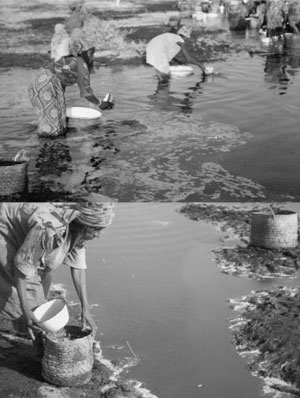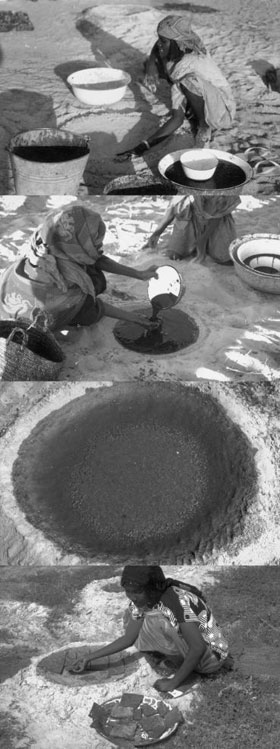Sources and Uses of Commercial Algae
FOOD
Cyanophyta
Some Nostoc species are regionally being used as food and herbal ingredients. Ge-Xian-Mi has been regarded as Nostoc sphaeroides, however, its taxonomic identity remains controversial. This Nostoc species has been used as a delicacy for hundreds of years and is found in rice fields from December to May in Hubei, China. Colonies of Ge-Xian-Mi are dark green and pearlshaped, develop from hormogonia, and can reach 2.5 cm in diameter. Dried Nostoc spp. balls are sold in Asian markets; they are stir-fried saute´ed with oysters, and used in soups and as thickeners for other foods.
Another species is Nostoc flagelliforme Bornet et Flahault, a terrestrial cyanobacterium that naturally grows on arid and semiarid steppes in the Northern and the Northwestern parts of China, where it is considered an edible delicacy with special medical value and great economic value.
The Chinese have used it as food for about 2000 years, as told in an old text dating back to the Jin Dinasty (265–316 AD). Its herbal values were recognized more than 400 years ago as recorded with other economic Nostoc species in “Compendium of Materia Medica” of 1578. N. flagelliforme is called “Facai” (hair vegetable) in Chinese because of its hair-like appearance. However, the pronunciation of “Facai” sounds like another Chinese word that means to be fortunate and get rich. Therefore, it symbolizes additionally good luck. N. flagelliforme has been consumed in China, especially Guangdong, and among Chinese emigrants worldwide on account of its food and herbal values as well as its spiritual image.
As this cyanobacterium has been collected and traded from old times, the resource is getting less and less as the market demand increases with economic growth. People gather it by tools, which more or less destroy the vegetation, and in addition to this loss by harvesting, pasturing of cattle is rapidly diminishing the resource. On the other hand, exploitation of land has greatly reduced the area producing N. flagelliforme, and the quality of the product is degrading. Hence, recently the Chinese government has prohibited further collection for the sake of environmental protection. A few phycologists in northern and western China were engaged for some years in attempts to cultivate this alga, but all in vain.
Also Arthrospira has a history of human consumption, which can be located essentially in Mexico and in Africa. About 1300 AD the Aztecs harvested Arthrospira from Lake Texcoco, near Tenochtitlan (today Mexico City) and used it to make a sort of dry cake called tecuitlatl, which were sold in markets all over Mexico, and were commonly eaten with maize, and other cereals, or in a sauce called chilmolli made with tomatoes, chilli peppers, and spices.
Very likely the use of Arthrospira as food in Chad dates back to the same period, or even earlier, to the Kanem Empire (9th century AD), indicating that two very different and very distant populations discovered independently the food properties of Arthrospira. Human consumption of this cyanobacterium in Chad was reported for the first time in 1940 by the French phycologist Dangeard in the little known Journal of the Linnean Society of Bordeaux. He wrote about an unusual food called dihe´ and eaten by the Kanembu of Chad, and concluded that it was a pure´e of the filamentous cyanobacterium Arthrospira platensis. However, at that time, his report failed to capture the attention it deserved because of the war. In 1966 the botanist Leonard, member of the 1964–1965 Belgian Trans-Saharan Expedition, confirmed the observations of Dangeard.
He reported finding a greenish, edible substance being sold as dry cakes in the market of Fort-Lamy (today N’Djamena, the capital of Chad). His investigation revealed that these greenish cakes, called dihe´, were a common component of the diet of the Kanembu populations of Chad and Niger, and that they were almost entirely composed of Arthrospira, blooming naturally in the salinesoda lakes of the region. Like tecuitlatl, dihe´ was commonly eaten as a thick, pungent sauce made of chilli peppers, and spices, poured over millet, the staple of the region. In 1976, Delpeuch and his collaborators of ORSTOM (Office de la Recherche Scientifique et Technique Outre-mer, Paris, France) carried out a study on the nutritional and economic importance of dihe´ for the populations of the Prefectures of Kanem and Lac in Chad. The use of Arthrospira by Kanembu was mentioned again in 1991 in a canadian survey of food consumption and nutritional adequacy in wadi zones of Chad, which suggested that dihe´ makes a substantial contribution to vitamin A intake.
Arthrospira is still harvested and consumed by the Kanembu who live around Lake Kossorom, a soda lake at the irregular northeast fringe of Lake Chad, in the Prefecture of Lac. Arthrospira is harvested from Lake Kossorom throughout the year, with a minimum yield in December and January, and a maximum in the period between June and September during the rainy season. The bloom is present as a thick blue-green mat floating onto the surface of the lake only few hours a day, early in the morning. When the sun is high, the temperature of the water rises, and the bloom disperses, therefore the harvesting begins at sunrise and it is over in about 2 h.

FIGURE 7.1 Harvesting of Arthrospira bloom from Lake Kossorom. (Courtesy of Dr. Gatugel Abdulqader.)
Only Kanembu women carry out the harvesting; men are banned from entering the water, because it is a deep rooted belief that they would make the lake barren. The harvesting begins early in the morning, and the work is coordinated by an old woman (the captain) who is responsible for guarding the lake even when the harvesting is over. Just before harvesting begins, the women form a line along the shore at positions assigned to them by the captain according to the village they come from, so as to avoid overcrowding in areas where the alga bloom is more abundant and where trampling and muddying of the water would reduce the quality of dihe´. The harvesting is carried on according to rules and procedures handed down from mother to daughter from time immemorial. With their basins, the women skim off the blue-green mat that floats at the surface of the water, especially along the shore, and pour it into twine baskets, which act as primary filters, or directly into jars (Figure 7.1).

FIGURE 7.1 Harvesting of Arthrospira bloom from Lake Kossorom. (Courtesy of Dr. Gatugel Abdulqader.)
In about 2 h the harvesting is over, and the women move to sandy areas close to the lake for the filtration and drying of the alga. The women dig in the sand round holes, 40–50 cm in diameter and about 5 cm deep, and line them with clean sand, which is
patted to obtain a smooth, firm surface.

FIGURE 7.2 Drying of Arthrospira and preparation of dihe´ on the shore of Lake Kossorom. (Courtesy of Dr. Gatugel Abdulqader.)
The algal suspension is then carefully poured into the holes, and the surface of the biomass is smoothed with the palm of the hand. Within a few minutes, almost all of the extracellular water will have seeped out of the biomass, and the dihe´ is then cut into 8–10 cm squares, 1–1.5 cm thick, and removed from the holes as soon as it is firm enough for the squares to be handled without breaking (Figure 7.2). The drying is completed on mats in the sun. Dihe´ is traded in the local markets, and in the markets of the main towns of Chad, from where it can also be taken across the borders of Chad to Nigeria, Cameroon, and other countries. It is estimated that about 40 tons of dihe´ are harvested from this lake Kossorom every year, corresponding to a
local trading value of more than US$100,000, which represents an important contribution to the economy of one of the poorest nations in the world.
Dihe´ is mainly used to prepare la souce, a kind of vegetable broth served with corn, millet, or sorghum meal, which occasionally can have fish or meat as additional ingredients. Well-dried dihe´ is crumbled in a bowl either by hand or with a mortar and pestle; cold water is then added to disperse the lumps, and the suspension is strained through a fine sieve to remove such solid impurities as sticks, grass, and leaves.
The suspension is poured away from most of the sand that settles to the bottom of the bowl. The cleaned dihe´ is cooked for 1–1.5 h, which further disperses the lumps, yielding a blue-green broth that still contains small amounts of plant debris and sand. This broth is transferred into a bowl, left to settle for 5–10 min to allow sedimentation of any residual sand, strained very carefully once more, and then poured over saute´ed onions. Salt, chili
peppers, bouillon cubes, and gombo (Hibiscus esculentus) are added, and la souce is then simmered and occasionally stirred until cooked.

FIGURE 7.2 Drying of Arthrospira and preparation of dihe´ on the shore of Lake Kossorom. (Courtesy of Dr. Gatugel Abdulqader.)
A minor utilization of dihe´ is as remedy applied onto wounds to speed up the healing process, or as a poultice to soothe the pain and reduce the swelling of mumps.
Arthrospira biomass has a high content of protein, about 55–60% of the dry matter, with respect to other foods such as milk, eggs, etc.; the proteins are low in lysine and sulfured aminoacids such as methionine and cystein, but their amount is much higher than in other vegetables, including legumina. Phycobiliproteins represent a major portion of proteins, and among them phycocyanin can reach 7–13% of the dry matter; carbohydrates reach 10–20% of the dry weight, and consist mainly of reserve products, while lipids account for 9–14% of the dry weight. The mineral fraction represents 6–9% of the dry biomass, rich in K, P, Na, Ca, Mn, and Fe. Group A, B, and C vitamins are also present, with an average β-carotene content of 1.5 mg g
-1 of Arthrospira, corresponding to 0.25 µg of vitamin A. Considering a recommended dietary allowance (RDA) of vitamin A of about 800 µg, and taking into account a natural 20–30% decrease in β-carotene level due to dihe´ storing conditions, we can say that a daily consumption of 5 g of dihe´ would provide about 100% of RDA.








